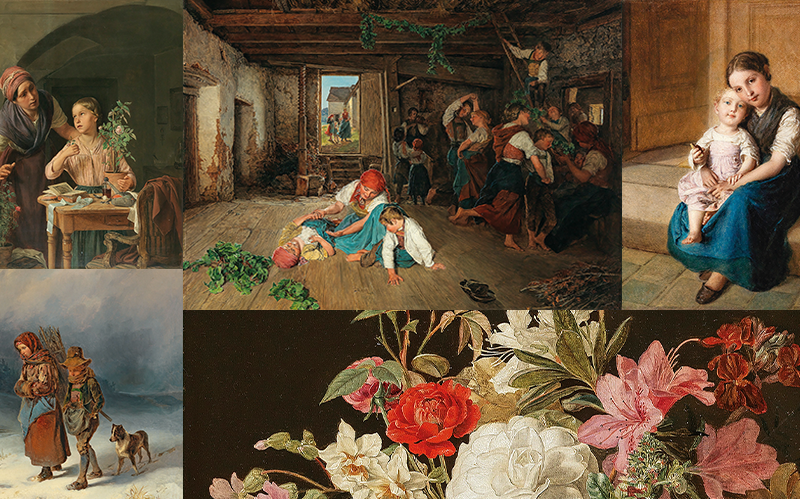
Cheerful children and wilting rosebuds
Genre paintings provide a sense of Biedermeier life. Influential artists from that period such as Ferdinand Georg Waldmüller and Rosalia Amon created evocative family scenes that still shape our idea of early 19th-century Vienna.
.
Ferdinand Georg Waldmüller
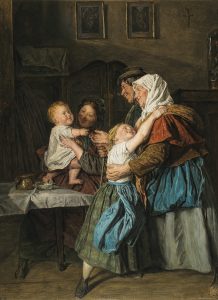
Ferdinand Georg Waldmüller’s approach to genre painting is epitomised by two of the pictures for sale in the 19th Century Paintings auction at Dorotheum on 9 November 2020. The paintings are being sold for the benefit of the sight loss charity the Vision Foundation, UK. Both are from the artist’s late creative period and are characterised by more fleeting, open brushwork with more pronounced light effects than we see in his earlier work. From the 1840s onwards, Waldmüller was becoming increasingly disenchanted with the Academy in Vienna and withdrew to Hinterbrühl in the Vienna Woods, where he devoted himself to genre painting.
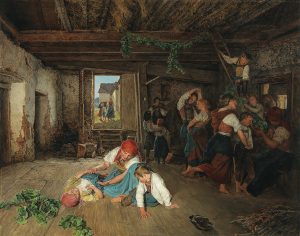
Simple, country folk and everyday life in the countryside inspired highly populated compositions, characterised by foreshortened perspectives and a complex interlocking of figures. His painting, entitled “The Grandparents’ Visit”, captures both the joy of a family reunion and the contrast between city and rural lifestyles – a distinction most clearly reflected in the palette chosen by the artist. While the interior of the city apartment and the clothing of the adult daughter are rendered in subdued, darker hues, the grandmother’s dress is painted in the resplendent primary colours of red, blue, and yellow. That same colour scheme can be found in the foreground figures in Waldmüller’s painting entitled “Preparing the Celebration of the Wine Harvest”, a large-scale picture which presents its story on three levels across the picture plane: in a dark rustic press house, we see a group of youngsters gaily decorating the old beams with fresh vine leaves for the approaching festival. The lighting is as unusual as it is expressive: the action takes place in the shady middle ground, staged, as it were, between the direct sources of light from the door and the window and the indirect light emanating from the front. The viewer’s gaze is repeatedly directed to small details such as the tiny interactions between the figures, the crumbling plaster on the left-hand wall, or the golden tufts of straw poking through the ceiling beams.
Rosalia Amon
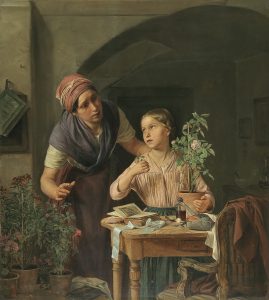
Rosalie Amon, a protégée of Waldmüller, who was one of a handful of female students at the Vienna Academy, can be compared to her mentor in terms of technique and composition. She specialised in floral still lifes, which she rendered in almost hyper-realistic style. Flowers constitute the key theme in her genre painting “The Wilted Rosebud”, in which a young girl is depicted holding a flowerpot containing a rose plant. She is indicating to her mother that the buds have wilted too soon. A number of objects placed on the small table in the foreground, a medicine bottle, a silver spoon, and an oval miniature seem to encourage the viewer to interpret the painting as a metaphor. The miniature might be presumed to show the likeness of an older sister who is suffering from an illness – a girl who, like the rosebud in the picture, will “wilt” before she can blossom into maturity. Rosalia Amon masterfully uses small gestures and innuendos like these to spark our imagination and invite us to spin a story from a her images.
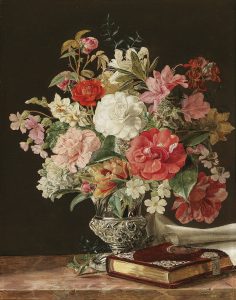
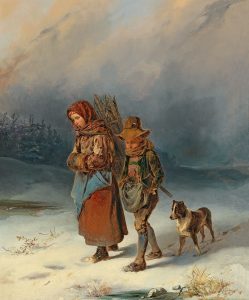
Die jungen Reisigsammler, 1850
Öl auf Holz, 63 x 49,5 cm, € 18.000 – 25.000
Johann Baptist Reiter and Eduard Ritter
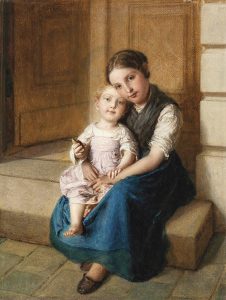
Linz-born painter Johann Baptist Reiter also challenged the boundaries of the Biedermeier style with his images. In the 1850s and early 1860s he developed his own technique of child portraiture, depicting his subjects with a naturalness and authenticity which more conventional portraits of children had hitherto lacked.
The universe of childhood also preoccupied the artist Eduard Ritter, who seems to have delighted in amusing his viewers with his story-telling genre paintings. However, unlike his contemporaries such as Waldmüller, Amon, or Reiter, Ritter apparently took his inspiration, less from observation of nature and everyday life, than from the pictorial inventions of 17th-century Dutch painters. His original motifs and humorous stereotypes seem to be drawn from real life and are highly recognizable and memorable. Another reason for the extreme popularity of Ritter’s paintings was their lack of a moralising message.
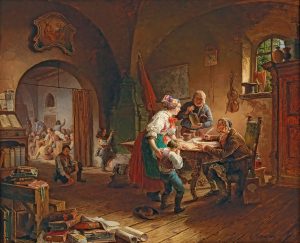
Öl auf Holz, 65,5 x 79 cm, € 10.000 – 14.000
His painting entitled “Village School”, shows a beautiful young mother and her shy child facing the slightly unusual seeming village teacher. The teacher’s belongings – a top hat and violin – are skillfully arranged behind him, on the wall, and windowsill. Apart from the central motif in the right-hand foreground, our gaze is directed into the classroom, where the “naughty” pupils can be seen tussling with one another. Two of them are already doing penance for their bad behavior: one can be seen standing in the corner, while the other is sweeping the floor. The many different planes in this picture each tell their own story, making this genre painting particularly appealing.
While each of these artists developed their own unique pictorial strategy, they share an ingenious knack for including strategically placed details in their pictures, providing little clues which the viewer can gather into stories like pieces of a jigsaw.
AUCTION
19th Century Paintings, 9 November 2020
Palais Dorotheum, Dorotheergasse 17, 1010 Vienna
19c.paintings@dorotheum.at
Tel. +43-1-515 60-355, 377













